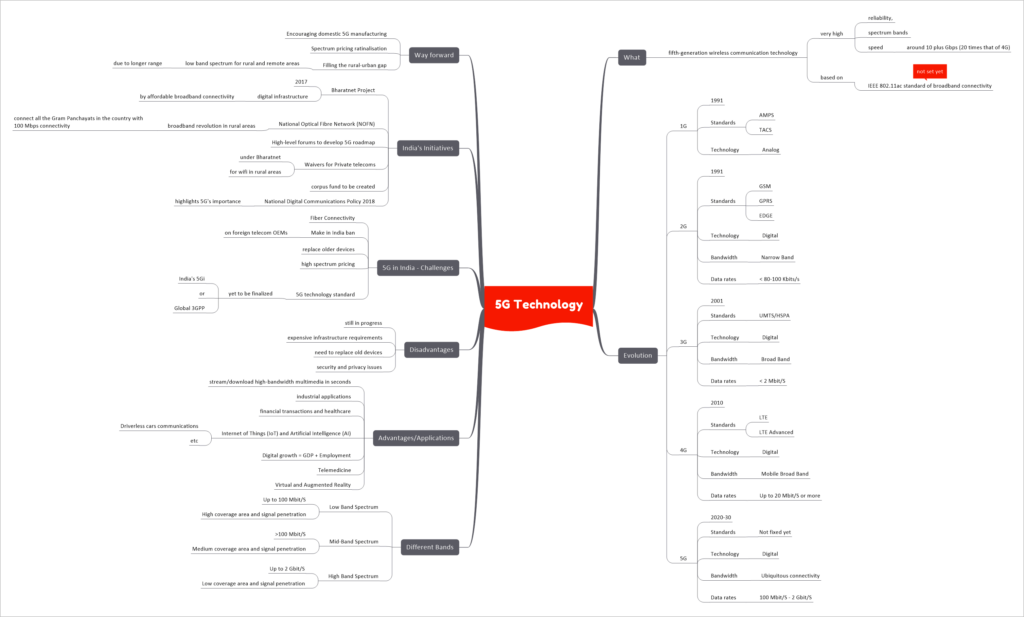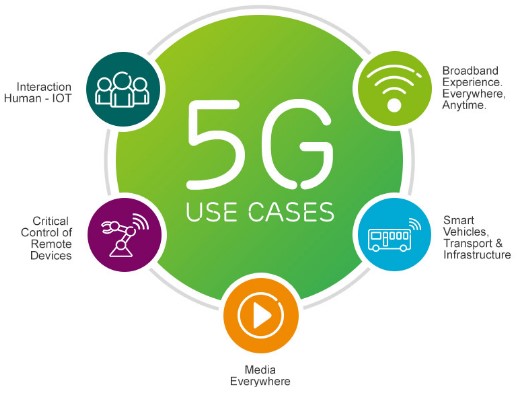5G Technology – Features, Pros, Cons and Challenges for India

India, like other global players, had in 2018 intended to launch 5G services as soon as possible, in order to take advantage of the improved network speeds and strength that the technology offered. With 5G technology, the government aims to provide internet connections with speeds up to 10,000 Mbps in urban areas and 1000 Mbps in rural areas.

This topic of “5G Technology – Features, Pros, Cons and Challenges for India” is important from the perspective of the UPSC IAS Examination, which falls under General Studies Portion.
What is 5G technology?
- 5G is a fifth-generation wireless communication technology that has very high reliability, spectrum bands and speed which is around 10 plus Gbps (20 times that of 4G).
- It is based on the IEEE 802.11ac standard of broadband connectivity. But a formal standard has not been set yet.
- The final standard for 5G will be established by the International Telecommunications Union (ITU).
Evolution
Different Bands of 5G
5G primarily operates across three bands: low, mid, and high-frequency spectrums, each with its own set of benefits and drawbacks.
Low Band Spectrum: The maximum speed of Internet and data exchange is limited to 100 Mbps in terms of coverage and speed (Megabits per second). This means that telecom companies can use and install it for commercial cellphone users who may not have specific demands for very high-speed Internet. However, the low band spectrum may not be optimal for specialised needs of the industry.
Mid-Band Spectrum: It has faster speeds than the low-band spectrum, but it has restrictions in terms of coverage area and signal penetration. This band could be utilised by industries and specialised production units to create captive networks that can be tailored to their specific demands.
High Band Spectrum: It has the fastest speed of all three bands, but its coverage and signal penetration intensity are severely limited. This band significantly improves future 5G technology applications such as the Internet of Things (IoT) and smart technologies, although it has significant infrastructure requirements.
Advantages/Applications of 5G technology
- With very high speed, 5G allows access to high-bandwidth multimedia such as HD videos, movies and games which can be downloaded in seconds.
- It enables high-speed data services that have industrial applications.
- It supports critical applications like financial transactions and healthcare.
- It will help incorporate Artificial Intelligence (AI) in our daily lives. It will enable cloud systems to stream software updates, music and navigation data to driverless cars seamlessly. It will also facilitate vehicle-vehicle communications in order to keep a safe distance from each other = fewer car accidents + less traffic congestion.
- It will facilitate the ecosystem for the Internet of Things (IoT) by enabling smart devices to exchange data seamlessly.
- With greater speed comes digital growth that will result in GDP rise and employment generation in the country.
- In the field of telemedicine, 5G enables instantaneous transmission of video and data = surgeons can operate remotely with a robotic scalpel.
- 5G mobile technology can usher in new immersive experiences such as Virtual reality (VR) and Augmented Reality (AR) with faster, more uniform data rates, lower latency, and lower cost-per-bit.
Disadvantages of 5G technology
- Technology is still in progress and research on its viability is going on.
- The speed on such scale (10,000 Mbps) is difficult to achieve considering the incompetent technological support in most parts of the world.
- Many of the old devices would not support 5G. Therefore all of them need to be replaced with new ones.
- Developing infrastructure for 5G is expensive.
- Security and privacy issues are yet to be resolved.
Challenges in adopting 5G in India
- Fiber Connectivity: India lacks strong backhaul for the transition to 5G. Backhaul is a network that links cell sites to the central exchange. However, 80% of cell sites in India are connected through microwave backhaul (high latency+limited capacity) and only 20% of sites are connected through fiber communication (low latency+unlimited capacity).
- Make in India challenge: The ban on certain foreign telecom OEMs (original equipment manufacturer) under Make in India upon which most of the 5G technology development depends, presents a hurdle in itself.
- Replace older devices: 5G technology would require newer handsets with the latest hardware which would mean the replacement of older phones with new and costlier phones (undesirable for low-income people).
- High Spectrum Pricing: India’s 5G spectrum pricing is many times costlier than the global average. This will be of disadvantage to India’s cash-strapped telcos.
- Selecting the Optimal 5G Technology Standard: The skirmish between the India’s 5Gi standard and the global 3GPP standard ought to be finalized for quickening 5G technology roll-out. While 5Gi carries apparent benefits, it also raises 5G India launch costs and interoperability problems for telcos.
India’s Initiatives
- Bharatnet project was launched in 2017 for providing digital infrastructure on a non-discriminatory basis by affordable broadband connectivity for all households. The objective is to facilitate the delivery of e-health, e-governance, e-banking, e-education, Internet and other services to rural areas.
- National Optical Fibre Network (NOFN) aims at bringing a broadband revolution in rural areas. Its objective is to connect all the Gram Panchayats in the country with 100 Mbps connectivity. As we have seen earlier, fibre provides strong backhaul, thus facilitates the adoption of 5G.
- High-level forum to develop 5G roadmap – Recently, the Department of Telecommunications set up a high-level forum to evaluate roadmaps and create a strategy to adopt 5G in the country by 2020.
- Waivers for Private telecoms -The government also announced a subsidy of Rs 3,600 crore to private telecom players such as Bharti Airtel, Vodafone India, and Reliance Jio to establish Wi-Fi in rural areas as part of the second phase of the BharatNet project.
- The government is working on creating a corpus of Rs 500 crore to fund 5G activity, particularly on research and product development.
- India’s National Digital Communications Policy 2018 emphasizes the importance of 5G when it mentions that the convergence of a cluster of revolutionary technologies including 5G, the cloud, Internet of Things (IoT) and data analytics, along with a growing start-up community, promise to accelerate and deepen its digital engagement, opening up a new horizon of opportunities.
Way forward
- Increasing domestic 5G manufacturing: Government should encourage and boost its local 5G hardware production at an exceptional rate if it needs to achieve the 5G India dream.
- Pricing Rationalisation: Rationalisation of this spectrum pricing is required so that the government generates sufficient revenue from the auction without affecting the roll-out plans for 5G in India.
- Filling the Rural-Urban Gap: 5G can be launched at different band spectrums and at the low band spectrum, the range is much longer which is useful for the rural areas.
Conclusion
Earlier deployment of 5G technology in India will help companies design and manufacture 5G products and solutions in India, thus creating some essential Intellectual Property Rights (IPR) in the 5G standard. It is high time that India strengthens the domestic telecommunication manufacturing market to enable local industries to capture both domestic as well as global market.





Please make it audio enabled
Sir, please give practice question and quick mind map.